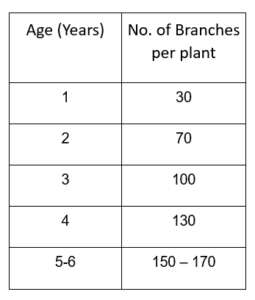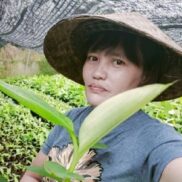Dragon Fruit tree Training and Pruning

This post is also available in:
This post is also available in:
![]() Español (Spanish)
Español (Spanish) ![]() Français (French)
Français (French) ![]() हिन्दी (Hindi)
हिन्दी (Hindi) ![]() العربية (Arabic)
العربية (Arabic) ![]() 简体中文 (Chinese (Simplified))
简体中文 (Chinese (Simplified)) ![]() Português (Portuguese (Brazil))
Português (Portuguese (Brazil))
Pruning is the practice of selectively removing plant parts (like branches, buds, spent flowers, etc.) to control the plant regarding the morphology and the balance between vegetative growth and reproduction (yield) for horticultural or landscape purposes.
What is the importance of pruning for the Dragon Fruit tree?
Pruning is important in dragon fruit crop production for maintaining the shape and size of the plants since they have a very fast growth rhythm and can easily become unruly and top-heavy. Keep in mind that a single, well-formed, robust vine of dragon fruit plant may produce up to 30 branches per year. Pruning also enables access to the plant, which assists in harvesting. Care should be taken to dispose of the cuttings as they have the potential to become weeds.
These are the step when to prune the Dragon Fruit Plant:
Step 1 – Before: Pruning should occur after the last harvest in May – June.
Step 2 – Clean main stem: Branches growing up the main stem must be removed.
Step 3 – Remove old growth: selectively remove the older branches from underneath.
Step 4 – Cut back clean: Cut branches back to the original stem
Step 5 – Set canopy size: keep only 1-3 sub-brunches per main branch. Remove the rest.
Step 6 – and later on: Pruning is needed to maintain fruit production and size ready for September-October flowering.
Here are the branches one dragon fruit plant has on average over the year:

Important Note When Pruning
Choose lighter green branches and leave the darker green branches alone. The darker ones are usually the more mature ones that can bear fruits. If it is the year of dragon fruit can cut the bit off the top of the branch off. In this way, it can induce more branches to shoot out from one stem.
Dragon fruits may need to be pruned once per growing season when they are still young and up to 2-3 times when mature and productive. The main pruning is performed after fruit harvest and minor interventions. The main goal is to remove any dead, tangled, unproductive stems-vines.
The farmer should not neglect to prune since the plants left to grow uncontrollably may shade each other and their center of the “canopy-stems,” decreasing photosynthesis and growth. The tangled stems to decrease the penetration of air and increase the risk of disease outbreaks. Finally, proper pruning can renew the plant and encourage flowering (and, as a result, fruit production).
Methods
1.Training pruning – This will be done from the beginning of the plantation. Eliminates all the shoots, leaving one or two pods until they reach the end of the support. The lateral stems must be removed. Once the top is reached, the plant should be pointed, allowing the development of lateral pods from the end easily. In this plant, training pruning should be practiced shortly after transplanting the cutting to maintain adequate structure and fruit production.
2.Cleaning pruning – This pruning consists of removing those pods that have been affected by pests or diseases and or that are poorly located. The cutting of the stem must be in the internode, and the affected material must be burned outside the farm.
During the plant’s growth, the lateral shoots should be pruned, leaving only the main shoot until it reaches the height of the fence post.
3.Production pruning – This aims to balance the plant at the vegetative level. The dragon fruit grows rapidly and produces extensive vegetation.
This pruning consists of removing damaged, dead, diseased, or too-long stems and, finally, lightening the crown. If no production pruning is done, there is a risk that a very dense mess of stems will form. This will make it difficult to harvest the fruit.
Why dragon fruit needs pruning?
- Optimize the vigor of the plants in order to produce fruits in greater quantity and quality.
- To favor the handling of the plants for the proper size.
- Cut the necessary, inconvenient diseased, cursed, and dry branches
- Make available branches suitable for the production of seedlings for a few plantings.
References:
- Hicksnursuries.com/trees-and-shrubs/pruning-plant-purpose
- Stfe.org.au/articles/pruning-pitaya-dragon-fruit/
- https://krishi.icar.gov.in/jspui/bitstream/123456789/23809/1/Dr.Karunkaran,%20vetnum%20proceeding%20.pdf
Dragon Fruit: Crop History, Nutritional Value and Uses
Dragon Fruit Plant Information and Environmental Requirements
Dragon Fruit Variety Selection
Soil Requirement and Land Preparation for Dragon Fruit
Dragon Fruit Planting Distances and Trellising
Dragon Fruit Pollination and Propagation
Dragon Fruit tree Training and Pruning
Dragon Fruit Water Requirement and Irrigation Systems








































































